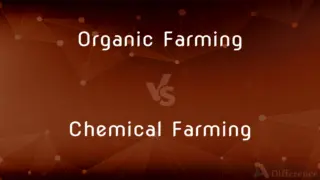Freeze Fracture vs. Freeze Etching — What's the Difference?
By Tayyaba Rehman — Published on November 23, 2023
Freeze Fracture involves splitting a frozen specimen to reveal internal structures, while Freeze Etching further sublimates ice to expose and detail those structures more.

Difference Between Freeze Fracture and Freeze Etching
Table of Contents
ADVERTISEMENT
Key Differences
Freeze Fracture and Freeze Etching are techniques used primarily in electron microscopy to study internal cellular structures.
In Freeze Fracture, a specimen is frozen and then physically cracked open, while Freeze Etching involves an additional step to remove ice and refine visible details.
The purpose of Freeze Fracture is to expose the interior surfaces of the sample, while Freeze Etching further reveals and accentuates the internal structures by sublimating ice.
While Freeze Fracture can provide a glimpse into the internal facets of a specimen, Freeze Etching can provide an enhanced, detailed view of those same facets by reducing ice interference.
It's notable that Freeze Fracture generally precedes Freeze Etching in a combined technique referred to as "freeze fracture-replication" or "freeze-fracture freeze-etching" to achieve detailed microscopic examinations.
ADVERTISEMENT
Comparison Chart
Method Complexity
Less complex with fewer steps
More complex due to additional etching step
Detail of View
Offers basic internal views
Provides more detailed, nuanced internal views
Steps Involved
Involves freezing and fracturing
Includes freezing, fracturing, and sublimating ice
Purpose
To expose internal structures
To detail internal structures by removing ice layers
Utilization in Techniques
Often used as a precursor to freeze etching
Can be used independently or following freeze fracture
Compare with Definitions
Freeze Fracture
It provides a view into microscopic entities without conventional sectioning.
Utilizing Freeze Fracture, researchers bypassed traditional slicing methods to observe cellular interiors.
Freeze Etching
Freeze Etching involves sublimation of ice to reveal detailed structures post-fracturing.
The specimen, once observed through Freeze Fracture, was further detailed via Freeze Etching.
Freeze Fracture
It is a precursor step in freeze-fracture freeze-etching techniques.
Freeze Fracture precedes freeze etching in sequential microscopy examinations for enhanced detailing.
Freeze Etching
It’s a procedure that can reveal the three-dimensional topography of cellular structures.
Freeze Etching enabled researchers to explore the 3D landscapes of cellular membranes and organelles.
Freeze Fracture
Freeze Fracture doesn’t involve sublimating ice for visibility.
Unlike its counterpart, Freeze Fracture alone won't refine visual details by sublimating ice.
Freeze Etching
It provides a more detailed and refined microscopic view compared to freeze fracture.
Freeze Etching unveiled more nuanced structural aspects that were obscured in the freeze-fracture stage.
Freeze Fracture
Freeze Fracture involves snapping frozen specimens for internal examination.
Freeze Fracture allows scientists to explore intracellular phenomena by revealing internal surfaces.
Freeze Etching
Freeze Etching is often utilized in conjunction with freeze fracture.
Scientists employed Freeze Etching following Freeze Fracture to gain a deeper insight into cellular internals.
Freeze Fracture
Freeze Fracture lacks the additional detailing step of Freeze Etching.
Though revealing, Freeze Fracture provides less intricate details compared to subsequent freeze etching.
Freeze Etching
Freeze Etching intentionally modifies the visibility of microstructures.
Applying Freeze Etching, the team enhanced visibility of internal structures, revealing minute details effectively.
Freeze Etching
A method of specimen preparation for electron microscopy in which a replica is made from a sample that has been rapidly frozen and then fractured along natural planes of weakness to reveal its internal structure.
Common Curiosities
What does Freeze Etching entail?
Freeze Etching involves sublimating ice from a fractured specimen to provide a detailed view of its internal features.
What is a notable limitation of Freeze Fracture?
Freeze Fracture might not reveal the minutest structures without the subsequent application of Freeze Etching.
Can Freeze Etching be performed without Freeze Fracture?
Typically, Freeze Etching is applied after Freeze Fracture to detail the exposed surfaces further.
Are Freeze Fracture and Freeze Etching always used together?
Often used together, but each can also be used independently depending on the research requirements.
Is Freeze Fracture applicable for studying all types of cellular structures?
While broadly applicable, the effectiveness of Freeze Fracture might vary depending on the particular structures and study objectives.
Why is Freeze Fracture necessary in microscopic studies?
Freeze Fracture allows scientists to explore and study internal cellular structures without using conventional sectioning.
How does the ice sublimation in Freeze Etching occur?
In Freeze Etching, the specimen is placed in a partial vacuum, facilitating sublimation of ice and revealing minute details.
What is Freeze Fracture?
It's a technique where a frozen specimen is fractured to expose and study its internal structures.
How does Freeze Etching enhance details?
Freeze Etching sublimates ice, reducing obstruction and revealing underlying structures with improved clarity.
Which technique between Freeze Fracture and Freeze Etching provides more detailed visuals?
Freeze Etching, as it further details the fractured specimen by sublimating ice and enhancing visuals.
What is the purpose of combining Freeze Fracture with Freeze Etching?
The combination, often called freeze-fracture freeze-etching, allows for both exposure and detailed visualization of internal structures.
Share Your Discovery

Previous Comparison
Baptist vs. Southern Baptist
Next Comparison
Organic Farming vs. Chemical FarmingAuthor Spotlight
Written by
Tayyaba RehmanTayyaba Rehman is a distinguished writer, currently serving as a primary contributor to askdifference.com. As a researcher in semantics and etymology, Tayyaba's passion for the complexity of languages and their distinctions has found a perfect home on the platform. Tayyaba delves into the intricacies of language, distinguishing between commonly confused words and phrases, thereby providing clarity for readers worldwide.












































